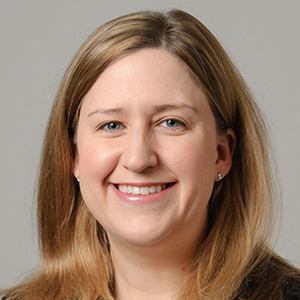The Burke Lab at UConn broadly seeks to design, synthesize, and characterize responsive polymeric materials for applications in regenerative medicine and tissue engineering.
In this seminar, two areas of research will be highlighted. One project will describe the generation of liquid crystalline (LC) phases within hydrogels, and the ability of LC phases to affect behavior of mesenchymal stem cells. A challenge with existing hydrogels is that there are limited numbers of biocompatible ways to incorporate anisotropy within a hydrogel, yet this is often desired because natural extracellular matrix of tissues may be ordered.

Kelly A. Burke,
University of Connecticut
Though solid state LC networks can display good biocompatibility, ordered microstructure, and tunable mechanical properties, the hydrophobic nature of LC molecules has traditionally hindered their use in polymer hydrogels that permit cell encapsulation. To overcome the challenges to generate biocompatible LC hydrogels, we describe the synthesis and characterization of thermotropic water-soluble main-chain LC polymers using alkyne-azide cycloaddition (AAC).
The strong hydrophobic core of the LC molecules results in ordering of the polymers, while hydrophilic poly(ethylene glycol) content imparts aqueous solubility. The polymers can be cross-linked in aqueous media to form gels, resulting in networks that maintain LC phases in both the dry and hydrated states and show excellent cell viability and proliferation for applications in tissue regeneration.
A second project involves synthetic modifications of silk fibroin (SF), a biocompatible protein that displays controllable degradability and mechanical properties. We will describe using a “grafting from” strategy to grow a dense layer of brush-like polymers on degradable silk fibroin films. The brushes have side groups to control polymer chain hydrophilicity, tune interactions between neighboring polymers, and facilitate drug attachment and release. Ultimately, this drug delivery surface has a distinct architecture with the potential to increase the efficiency of therapeutic delivery and permit more precise tuning of delivery profiles compared to drug encapsulation methods.
Kelly A. Burke earned a B.S.E. from the University of Connecticut in chemical engineering, following which she went on to receive her Ph.D. in macromolecular science and engineering from Case Western Reserve University. Her dissertation research was conducted in the laboratory of Prof. Patrick Mather and focused on the structure-property relationships of siloxane-based main-chain liquid crystalline elastomers. Kelly then went on to join the laboratory of Prof. David Kaplan in the Department of Biomedical Engineering at Tufts University as a postdoctoral fellow, where she generated in vitro 3D models of inflamed human adipose tissue.
For her graduate and postdoctoral work, Kelly is the recipient of a National Science Foundation Graduate Student Research Fellowship and a NIH Ruth L. Kirchstein Postdoctoral Fellowship. She then joined the Polymer Program and the Department of Chemical and Biomolecular Engineering at the University of Connecticut, where she currently holds the rank of associate professor and department head.
Her research group focuses on the synthesis and structure, property, function relationships of biomaterials, with particular emphasis on anisotropic and naturally sourced materials. Her recent awards include a NSF CAREER Award (2020), a NIH Maximizing Investigators’ Research Award (2022), and a Young Investigator Award from the American Chemical Society Division of Polymeric Materials: Science and Engineering Division (2022).